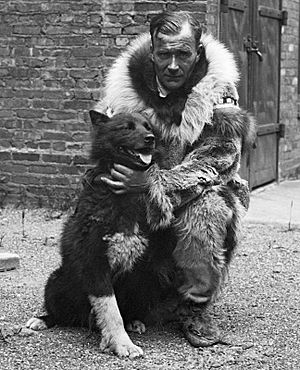Gunnar Kaasen facts for kids
Quick facts for kids
Gunnar Kaasen
|
|
|---|---|

Gunnar Kaasen with Balto
|
|
| Born | March 11, 1882 Burfjord valley, Sweden-Norway
|
| Died | November 27, 1960 (aged 78) Everett, Washington, United States
|
| Occupation | Musher |
Gunnar Kaasen (March 11, 1882 – November 27, 1960) was a brave musher, born in Norway. He became famous for driving a dog sled team in 1925. He carried important medicine to Nome, Alaska, saving the city from a serious illness. This journey was the final part of a long dog sled relay race.
Contents
Gunnar's Early Life
Gunnar E. Kaasen was born in a place called Burfjorddalen in Norway. This was in the region of Troms. In 1903, he moved to the United States. He went there to search for gold. Gold had been found near Cape Nome a few years earlier. This discovery caused a "gold rush," where many people moved to the area.
Kaasen became a very skilled musher. A musher is someone who drives a dog sled team. He lived in Nome, Alaska. Even though the gold rush slowed down, Nome was still an important port. But it was often covered in ice from October to June. During these cold months, dog sledding was the main way to travel. It was also how people communicated with the outside world.
The Great Serum Run
In 1925, a dangerous sickness called diphtheria threatened Nome. Diphtheria is a serious infection that can make it hard to breathe. It can even be deadly. The illness could easily spread to other villages in northern Alaska. Many local children had no protection against this disease.
Nome's port was frozen, so ships could not bring supplies. There were no train tracks or roads to northern Alaska either. Airplanes were very new back then. The few planes in Alaska had open cockpits. They had never flown in winter.
So, the Governor of Alaska decided to send medicine by dog sled. This medicine was called antitoxin. It could stop the diphtheria from spreading. The medicine was first sent by train from Anchorage to Nenana. From Nenana, twenty mushers and over one hundred dogs took turns. They relayed the medicine 674 miles (1,085 km) to Nome. This amazing journey became known as the "Great Race of Mercy."
Kaasen's Heroic Journey
Gunnar Kaasen was supposed to carry the medicine on the second-to-last part of the relay. He would go from Bluff to Point Safety, Alaska. The package of medicine weighed about 20 pounds (9 kg).
At Bluff, another musher named Charlie Olson gave the medicine to Kaasen. Gunnar started his journey with 13 dogs. His lead dog was a brave Siberian Husky named Balto. Kaasen traveled through the night. The winds were so strong that his sled flipped over. He almost lost the important medicine! It was so hard to see that he could not even see the dogs closest to his sled.
Kaasen arrived at Port Safety earlier than expected. It was 2 AM on February 2. Ed Rohn, the next musher, was asleep. So, Kaasen decided to keep going. He drove the remaining 25 miles (40 km) to Nome. He reached Front Street at 5:30 AM. In total, Kaasen traveled 54.3 miles (87 km) with the medicine.
Saving Nome
Kaasen gave the medicine to Dr. Curtis Welch. He was the only doctor in Nome. The doctor quickly gave the medicine to the sick people. After this, no more deaths from diphtheria were reported in Nome.
A second supply of medicine arrived five days later. It was also brought to Nome by dog sled. Before 1925, diphtheria killed many people in the U.S. The worldwide news about this event helped encourage people to get vaccinated. This greatly reduced the number of deaths from diphtheria.
A Famous Musher and Dog
All the mushers who took part in the relay received an award. They also got paid for their efforts. The company that made the medicine gave medals to everyone in the first relay.
Gunnar Kaasen became very famous. He received $1,000 from the medicine company. He was even offered a role in a movie! But his lead dog, Balto, became even more famous.
On December 17, 1925, a bronze statue of Balto was put up in Central Park in New York City. The statue honors the amazing spirit of all the sled dogs. It says they relayed medicine 600 miles over ice and through blizzards. It mentions their "Endurance · Fidelity · Intelligence."
Balto also appeared in Madison Square Garden in front of 20,000 people. Another statue of a sled dog was put up in Anchorage, Alaska. Many people think it is also Balto. But its plaque honors "all dog mushers and their heroic dogs."
Gunnar Kaasen lived in Everett, Washington, from 1952 until he passed away in 1960. He was 78 years old. He is buried next to his wife, Anna, in Everett.

